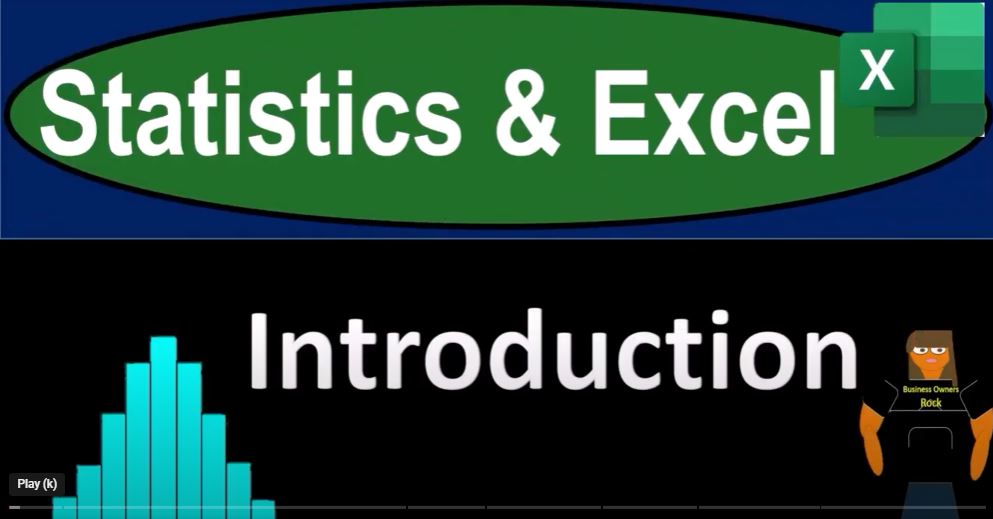In today’s data-driven world, the ability to analyze and interpret data is a skill of immense importance. Whether you’re making personal decisions, evaluating business performance, or understanding global trends, the utilization of statistics and tools like Microsoft Excel is paramount. This course aims to provide you with a solid foundation in both statistical principles and Excel’s practical application, enabling you to unravel the mysteries hidden within data and make informed decisions.
Understanding Statistics: More Than Meets the Eye
When we hear the term “statistics,” we might think of numbers and charts that summarize complex information into a few key points. However, statistics is much more than that. It’s the art of extracting meaningful insights from data, using a range of techniques to explore, analyze, and interpret information. Statistics plays a crucial role in various aspects of our lives, from personal decision-making to scientific research, from news analysis to entertainment evaluations.
While statistics may appear mysterious to some, it is integral to our daily lives, informing the choices we make and the conclusions we draw. For instance, when we assess news claims, compare sports team performance, seek employment advancement, or make purchases, statistics help us navigate complex scenarios and make more informed judgments.
The Importance of Data and Statistics in Various Fields
This course delves into the multifaceted world of data and statistics across various domains. Whether it’s deciphering medical research, predicting financial trends, analyzing weather patterns, understanding educational outcomes, or identifying societal shifts, statistics is a common thread. The course showcases the widespread applicability of statistical analysis by drawing examples from different fields, enabling you to grasp the diverse ways statistics influences our lives.
Dispelling Misconceptions: Data and Statistics in Focus
Misconceptions often cloud our understanding of statistics and data analysis. The belief that statistics oversimplify complex situations by distilling them into a few numbers is a common fallacy. While statistics do aid in summarizing information, their true power lies in their ability to unveil intricate patterns, relationships, and insights within data. The objective is not to oversimplify, but to strike a balance between clarity and depth, preserving the richness of information.
Navigating Terminology: Data, Datum, and Statistics
The terms “data” and “statistics” sometimes create grammatical ambiguity. “Data” is technically a plural term originating from the Latin “datum,” which refers to a single piece of information. Despite this, modern usage often treats “data” as a singular noun when discussing collections of information. Similarly, “statistics” is both singular and plural, depending on context. Understanding these nuances aids effective communication and underscores the importance of precise language in statistical analysis.
Excel: Your Partner in Data Analysis
Microsoft Excel serves as a powerful tool in the world of statistics. It allows you to organize, analyze, and visualize data in a comprehensible manner. While statistics involve mathematical principles, Excel simplifies the application of these principles through functions and formulas. It provides a platform to create graphs, charts, and visual representations that aid in understanding complex data patterns. Excel bridges the gap between mathematical analysis and practical insights.
Course Goals: Gaining Proficiency in Statistical Analysis
The primary goal of this course is to equip you with the principles of statistics, enabling you to draw meaningful conclusions from data. As you progress, you’ll delve into probability, which assists in quantifying uncertainty and predicting outcomes. By grasping these tools, you’ll be better equipped to make informed decisions in various contexts, whether it’s predicting election results or analyzing financial trends.
Challenges and Opportunities: Two Sides of Statistical Analysis
Two key challenges in statistical analysis are comprehensive data analysis and statistical inference. Comprehensive data analysis involves extracting meaning from complete data sets, often used to predict future outcomes. On the other hand, statistical inference involves making broader conclusions about a population based on a sample. Both approaches require a balance between detail and simplicity, highlighting the necessity of appropriate tools for each scenario.
Beyond Formulas: Embracing the Complexity of Statistical Analysis
Statistical analysis is not merely about plugging numbers into formulas. It’s a nuanced process that demands thoughtful exploration and interpretation. Rather than oversimplifying complex data, the aim is to develop an understanding of the underlying principles and strategies that drive statistical reasoning. This comprehension empowers you to unravel intricate patterns and make informed judgments.
The Art of Data Interpretation: Navigating Complexity
Interpreting data involves more than just condensing information into a few numbers. It’s about capturing the richness and diversity of data while maintaining clarity. Statistical analysis strives to strike a balance between simplification and detail, revealing insights without sacrificing important nuances. Just as an artist skillfully combines colors to create a masterpiece, you’ll master the art of data interpretation to uncover meaningful insights.
Conclusion: Empowering Decision-Making Through Data and Statistics
In a world saturated with data, the ability to decipher its intricacies and derive meaningful insights is a valuable skill. This course empowers you to wield statistical tools and Excel to their full potential, enabling you to navigate the sea of data with confidence and make informed decisions. By embracing the true essence of statistics and understanding its broader implications, you’ll be better equipped to unravel the mysteries hidden within the data-driven landscape of our modern world.

